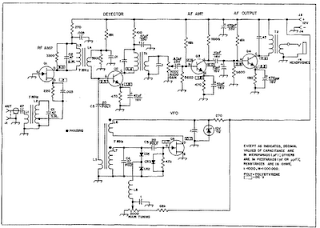----------------------------------------------------
From AA1TJ:
Wahoo...Dale, you amazing!
You are my first QSO with the Vanguard 1 reproduction satellite beacon transmitter. My circuit is a fairly close copy of the one shown on the lower left-hand corner of the 1959 CQ Magazine article (notice the output signal pick-off shown in this schematic is incorrect, or at least incomplete). My circuit uses link-coupled output impedance matching, which is similar to the only other documentation that I was able to dig up. The attached image "Early_Microlock_Bcn.jpg" was snipped from an original NASA report on the transmitter used in early airborne and sub-orbital tests leading up to the Vanguard flights.

Yes, you heard correctly. I'm using a Philco 2N504 surface-barrier transistor, but please let me back up a bit.
Roger Easton (a native Vermonter...and still resides here!) was at the helm of the communications development for the Vanguard/Minitrack project. Of the Vanguard "grapefruit" satellite beacon transmitters, he wrote in the May 2008 issue of High Frontier magazine
"We tried subminiature tube transmitters first. They worked marginally. Finally, Bell Telephone/Western Electric developed a very nice transistor for the task, and the problem was solved."
However, that leaves out a small detail. They first tried Philco surface-barrier transistors, which worked fine on the bench, however two problems were discovered. They were found to be too temperature sensitive; the RF output power from the one-stage transmitter dropped excessively at elevated temps. Secondly, there was some issue with the packaging that produced erratic operation when the transistor was rotated positionally. The Western Electric devices proved better on both counts.
The WE transistor appears to be "unobtainium" these days. That, plus the fact that my circuit won't be flying up to space anytime soon, prompted me to settle on a Philco 2N504. Although my device was manufactured in September of 1959 (Vanguard TV-4 - re-Christened "Vanguard 1" - first orbited on March 17, 1958), the 2N504 was an off-the-shelf item on the launch-date.
The only other obvious difference is the Vanguard 1 beacon circuit operated on 108MHz, whereas mine is presently working on 14.0596MHz. I recently had it running as a beacon on 10m for 48 hours but I had no luck given present band conditions.
The receiver is a simple, 0-V-0 regenerative set using a single Raytheon QF721 (fabricated in February 1953). I heard little activity on 20m when I started up my auto-keyer this morning. I had it looping 3X1 CQs whilst I worked on another project. To make matters more difficult, the exhaust fan was running in my shop and it happened to be raining heavily when you called. Worse yet, the receiver had drifted off my calling frequency by the time you called. I barely discerned a high-pitched CW "1" or "J"...which prompted me to quickly switch off the fan and re-tune. You were subsequently a solid 579.
Of course my heart jumped when I heard you calling me...how I love that feeling! And it was a fabulous QSO so far as I'm concerned. Following our contact I opened my metal index card file box and pulled out the QSL that you sent to me following our "Code Talker" QSO. To think I now have another happy memory to add to that one! Thank you once again, Dale. It figures you'd be the one to pick-off my unannounced presence on the 20m QRP calling frequency with 25mW. Well done, OM.
Also, you might enjoy this video of the actual launch, including some interesting control room audio banter. It may be found here: http://www.nrl.navy.mil/vanguard50/index.php. The way at least one of them nervously repeats, "Keep going baby!" gives some indication of the pressure these guys were under...having failed so spectacularly on two previous occasions.
All the best,
Mike, AA1TJ
On Mon, Jun 25, 2012 at 11:51 AM, Dale Parfitt wrote:
Hi Michael,That was fun!I first heard you on my SG-2020 rig, but did not have a paddle handy, so I fired up the K3. I don't ever recall having QRN on 20M, but it was bad. Without it, you were 579 and even with it, 569 towards the end of the QSO.I just happened to be QRV on 060 listening when I heard your CQ's. Not bad for a 25mW signal from (I think you said) a Philco transistor.73,Dale W4OP
Our book: "SolderSmoke -- Global Adventures in Wireless Electronics" http://soldersmoke.com/book.htm Our coffee mugs, T-Shirts, bumper stickers: http://www.cafepress.com/SolderSmoke Our Book Store: http://astore.amazon.com/contracross-20












